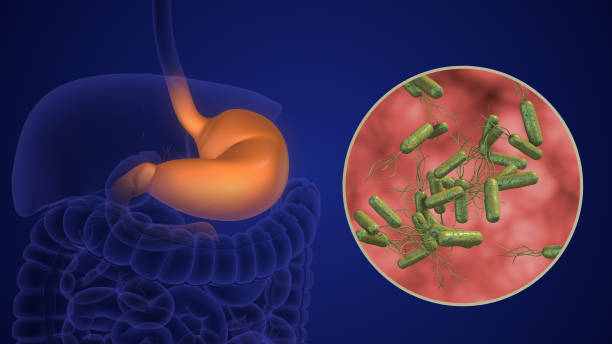
Helicobacter pylori (H. pylori) is a spiral-shaped bacterium that infects the stomach lining, affecting nearly half of the world’s population. It is one of the leading causes of stomach health problems, peptic ulcers, and gastritis, and can increase the risk of stomach cancer. Although many people may not experience symptoms, it is important to understand H. pylori and how to treat it effectively. In this article, we’ll cover the symptoms of the devastating H. Pylori, causes, treatment options, and the proper usage of an H. pylori kit for dosage.
What is H. Pylori?
H. pylori thrives in the highly acidic environment of the stomach. The bacteria weaken the stomach’s protective mucous lining, leading to inflammation (gastritis) and the potential development of ulcers in the stomach or small intestine. The devastating H. pylori is mainly transmitted through contaminated food, water, or direct contact, such as saliva, and is more common in areas with poor sanitation.
Symptoms of H. Pylori Infection
Although many people infected with H. pylori show no symptoms, those who develop ulcers or gastritis may experience the following:
- Abdominal pain – A burning sensation, often worse on an empty stomach.
- Bloating – A swollen, full feeling in the abdomen.
- Frequent burping – Increased gas production.
- Loss of appetite – Reduced interest in food due to discomfort.
- Nausea or vomiting – A frequent queasy feeling.
- Unexplained weight loss – Losing weight without dieting.
- Indigestion – Persistent stomach discomfort or heartburn.
In severe cases, such as ulcers, symptoms may include vomiting blood, black stools, or intense abdominal pain that requires immediate medical attention.
Causes and Risk Factors
H. pylori infections are caused by ingesting the bacteria through contaminated food, water, or close contact with an infected person. Risk factors include:
- Living in crowded conditions – Increased exposure to infection.
- Poor sanitation – Areas with unclean water and food increase the risk.
- Low-income regions – More common in developing countries.
- Family history – A higher likelihood of infection if a family member has it.
Diagnosis
Several tests can diagnose H. pylori infection:
- Blood test – Detects antibodies to H. pylori.
- Stool antigen test – Identifies H. pylori proteins in stool.
- Breath test – Measures carbon dioxide levels after consuming a urea-based solution, indicating the presence of H. pylori.
- Endoscopy – Visualizes the stomach lining and takes a biopsy if needed.
Treatment for H. Pylori
The devastating H. pylori infection is treated with a combination of antibiotics and medications that reduce stomach acid. The primary goal is to eradicate the bacteria, heal any ulcers, and prevent recurrence.
Common treatments include:
- Antibiotics – Two or more antibiotics are prescribed to prevent bacterial resistance. Typical choices include clarithromycin, amoxicillin, and metronidazole.
- Proton pump inhibitors (PPIs) – These drugs, such as omeprazole or lansoprazole, reduce stomach acid and help ulcers heal.
- Bismuth subsalicylate – Sometimes added to help kill the bacteria and protect the stomach lining.
H. Pylori Kit Dosage
In some cases, doctors prescribe an H. pylori kit containing a combination of antibiotics and acid-reducing medications. The typical H. pylori kit consists of the following:
- Amoxicillin – 750 mg
- Clarithromycin – 500 mg
- Omeprazole – 20 mg
Dosage Instructions:
The standard dosage involves taking the following regimen twice daily for 7-14 days:
- Amoxicillin: One 750 mg tablet in the morning and evening.
- Clarithromycin: One 500 mg tablet in the morning and evening.
- Omeprazole: One 20 mg capsule in the morning and evening.
The treatment duration is usually 14 days, but in some cases, a 7-day regimen is also prescribed, depending on the severity of the infection and the patient’s response to treatment. Completing the entire course of antibiotics is crucial to ensure the bacteria are fully eradicated and to avoid resistance.
Tips for Taking H. Pylori Kit:
- Follow your doctor’s instructions closely – Do not skip doses, and complete the entire course of treatment.
- Take medication with food – This can help reduce side effects such as nausea.
- Avoid alcohol – Alcohol can interfere with the antibiotics’ effectiveness and cause side effects.
- Manage side effects – Common side effects include diarrhea, nausea, and taste changes. Contact your doctor if side effects become severe.
Preventing H. Pylori Infection
Preventing the devastating H. pylori infection involves practicing good hygiene and ensuring food and water safety:
- Wash your hands regularly, especially before eating and after using the restroom.
- Drink clean water to avoid contamination.
- Cook food thoroughly to eliminate bacteria.
- Avoid close contact with those who are known to have H. pylori.
Final Thoughts
H. pylori infection is common and often asymptomatic, but it can lead to serious gastrointestinal issues if left untreated. Proper diagnosis, combined with a full course of antibiotics, is the key to eliminating the bacteria and preventing complications like ulcers or stomach cancer. If prescribed, the H. pylori kit offers an effective and structured treatment plan with specific dosages. Following your doctor’s advice and taking the medication as directed will ensure successful treatment.
By practicing good hygiene and completing prescribed treatments, you can effectively manage H. pylori infections and reduce the risk of future complications.







